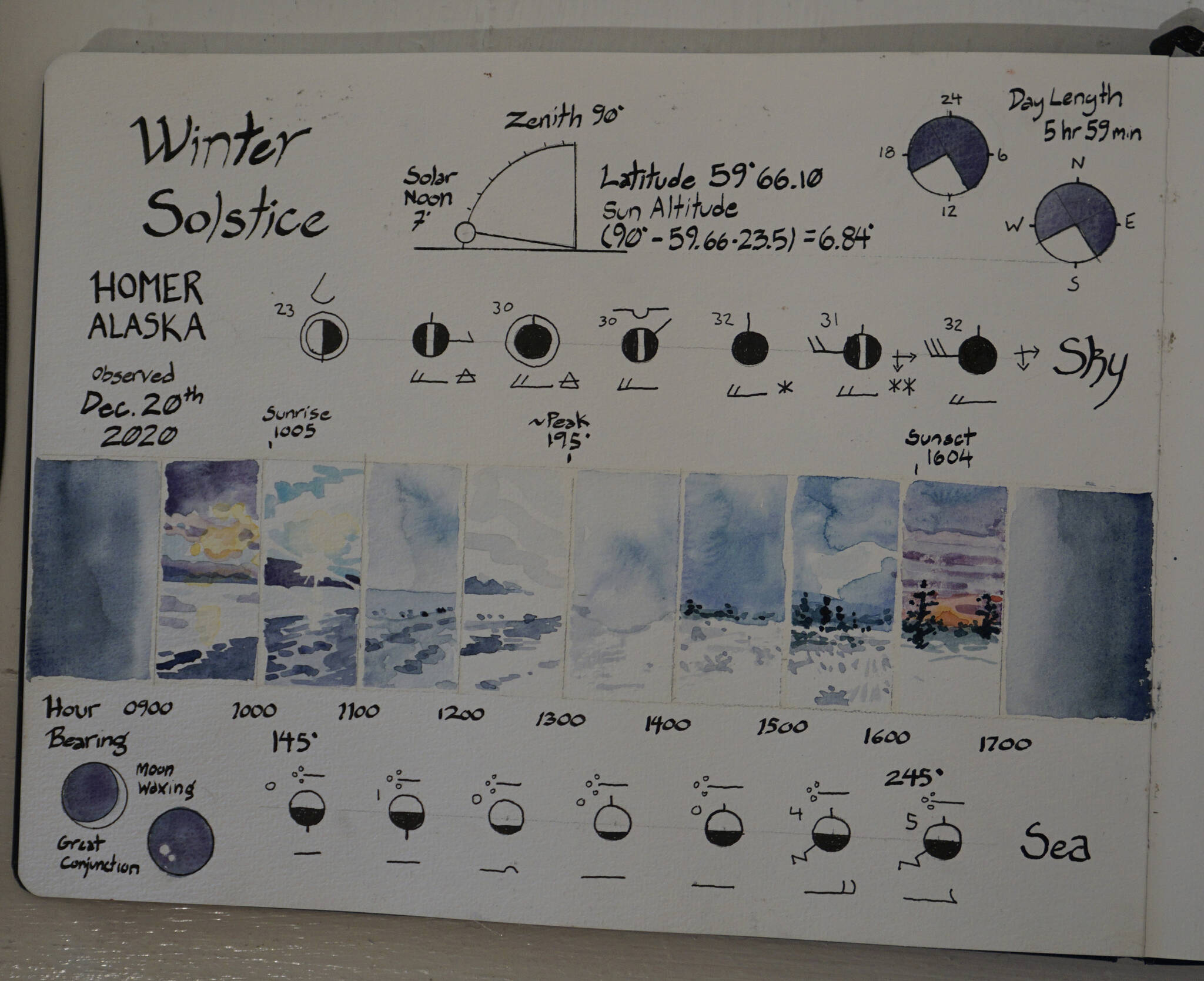Homer artist and naturalist Kim McNett has become known in Homer and Alaska for her finely detailed, well crafted nature journals. This month she completes her first artist in residence at Bunnell Street Arts Center. Her show, “Naturalist Notebook,” provided a backdrop to open studios and workshops she held. The show ends Friday, but the residency has served to help McNett develop a concept for a Homer peatlands mural she will do at the Homer Airport.
“This is going to be a pretty high public exposure piece,” McNett said of her project and residency. “I took it as a scouting period.”
Like the late R.W. “Toby” Tyler, McNett uses as her subject the environment of Alaska and the Kenai Peninsula. In the 1980s and 1990s, Tyler became known for his detailed watercolor sketches of local plants and wildflowers. McNett has the same precision of detail as Tyler, but takes the form a step further, using her art to tell the stories of the world she encounters on her human-powered trips around Alaska.
With her partner Bjørn Olson, whose video of their adventures is included in the exhibit, McNett has traveled the Iditarod Trail, the Seward Peninsula, elsewhere in Alaska and much of the Arctic coast. In one expedition they traveled by fat tire bike and pack raft from Point Hope to Utqiagvik.
All along the way, McNett drew what she saw, like early historic semi-subterranean sod houses at Atagniq between Wainwright and Utqiagvik. Some of her notebooks are in the exhibit, with white gloves to handle them and examine the pages.
“That’s what I really wanted to share with the community was … artistically interpreting the landscapes we visited and have a deeper connection,” McNett said.
Her journal entries don’t just include drawings, but detailed notes. On the winter solstice of 2020, she sketched the sky and beach hourly from sunrise to sunset, including notes about the tide level and the altitude of the sun above the horizon at solar noon.
Another entry shows the texture of Beluga Lake last year before snow covered the ice. She drew formations of methane gas frozen in the ice, giving it names like “amoeba” or “bubble towers.” Selected pages from her journals have been blown up on prints in the exhibit.
Scientists might write papers on methane gassing from Alaska lake beds, but McNett said she sees her journals as a way to make that science more accessible.
“My goal is that my role can be to understand and experience that science, and then turn it into something that’s captivating to people that science may not reach as effectively,” she said on First Friday for an artist’s talk and opening of her exhibit.
McNett said she also uses her artist’s perspective to help people understand the human and natural world. In her work as a naturalist for the Center for Alaskan Coastal Studies at the Peterson Bay Field Station, McNett saw how people would be frustrated understanding a large depression that once held a Dena’ina house.
“One gal looked at me and said, ‘How do you know that’s not another hole in the forest?’” McNett said.
To make it understandable, using archaeological and ethnological research, she drew the house as it would appear intact and alive.
“I tried to get people to visualize it not as some damp place in the ground, but a place bursting with life and activity and warmth,” she said. “It’s a huge home.”
The airport peatlands mural is not yet complete. McNett said her residency has given her an approach in how to tell the story of the peatlands that surround the airport — the peatlands it’s built upon.
“The fact that the airport is built in the Beluga wetlands, (Public Works Director) Jan Keiser and Bunnell have been supportive of this idea that we make a mural that’s supportive of our peatlands,” she said.
Through the Homer Drawdown Project, a program to come up with attainable solutions to reduce carbon emissions and mitigate climate change, McNett helped develop one concept: preserving peatlands as high-value carbon sinks. That has helped draw attention to protecting peatlands and not filling them for industrial and commercial uses.
The airport mural will tell the story of Homer’s peatlands.
“I’m playing on this whole cross-sectioning of the landscape and doing pop-outs,” she said. “… Block diagramming rather than cross sections.”
Like her approach to adventure travel, where simple technology like bicycles use modern materials such as graphic fibers, McNett’s art is low-tech — pen and ink and watercolor on paper — that she will combine with digital technology. Rather than paint the mural on an airport wall, McNett will digitize it and then print it on custom, high-pressure laminate that embeds the ink in the material. That’s similar to the technique she uses for making interpretive signs. It’s vibrant and weather resistant.
“I thought that would be the best way for me to present that work,” she said.
Bunnell Street Arts Center also has been developing technology to augment the experience of physically visiting the gallery. With the COVID-19 pandemic at times having shut the gallery, Bunnell’s website now includes more than simple announcements of shows. The page on McNett’s show includes her artist talk and a virtual reality tour of the exhibit itself. That program allows the viewer to walk through the exhibit and even zoom in on art.
Reach Michael Armstrong at marmstrong@homernews.com.

